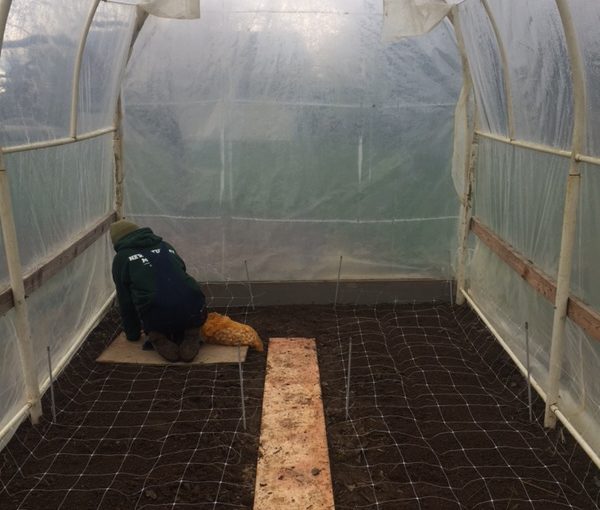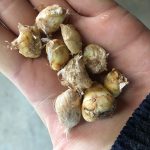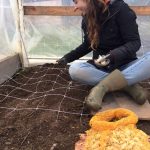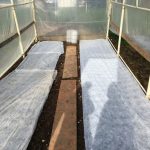MONDAY
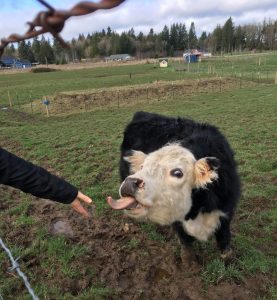
Photo: Allie Kuppenbender
Right away Monday morning we began with our chores. Again, these include misting the blueberry cuttings; checking the west pasture; watering greenhouse cuttings; and feed the animals. This included filling the bird feeders, putting out tuna for Blackie the cat, and giving the cows (Reggie, Boyfriend, and Betsy) next-door apples. These are things we do everyday right when we get to Thistlehook. It’s nice to know exactly what to do right when we get there regardless of if Doug is around immediately or not.
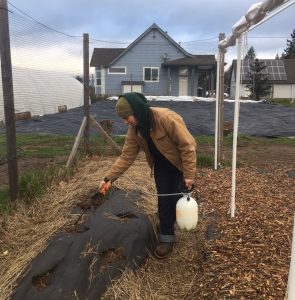
Photo: Anika Goldner
After our normal chores, we got to work mixing up a neem oil foliar spray for the backpack sprayer. To make this spray, we mixed 2 tablespoons neem oil to 1 gallon of water. The spray was used on the Turkish Bay to help alleviate the scale pressure and on the peonies to help ward off botrytis. For best results, spray every leaf top and bottom as well as soak the ground around the emerging eyes of the peonies.
We then got to work planting freesia corms in the unheated greenhouse. To do this, we rolled out HortiNova netting to act as a spacing guide. Two corms went in each square–one in the upper lefthand corner, one in the lower righthand corner. Doug had two different varieties to plant: Albertville (white variety) and Gold River (yellow variety). There were 500 corms of each and all of them fit into the two 3ft x 20ft beds inside of the unheated greenhouse. To plant, you just stick the corm 1-2 inches into the dirt and cover back up. After finishing with the planting, we removed the HortiNova (it was just used as a spacing guide, but will be added back to the beds when the freesias are about 2 inches tall for support) and covered the rows with row cover. The row cover, combined with the protection from the greenhouse, will ensure the corms don’t get too cold. They don’t like for their surroundings to get below 50 degrees Fahrenheit.
After finishing in the unheated greenhouse, we moved to the greenhouse for some seeding.
Here’s what we seeded:
- two 72s (144 total)–Cerinthe Major, Kiwi Blue variety
- 72–Matthiolas (Stock), Glory Lavender variety
- 72–Matthiolas (Stock), Noble White (untreated) variety
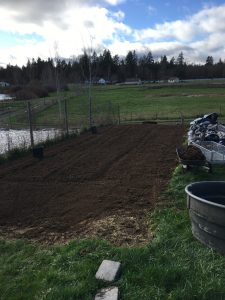
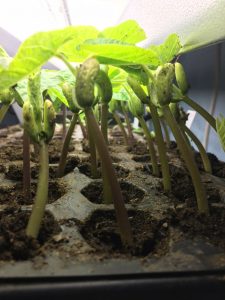
Photo: Allie Kuppenbender
The afternoon was filled with transplanting yarrow into the field in Doug’s backyard. So much yarrow! That field is going to look beautiful in full bloom this summer.
A side note: the garage greenhouse is doing it’s job really well! The potted up yarrow is looking really happy and has green new growth. The marigolds and beans from the seed germination trial popped up over the weekend. This means that the grow lights and heater in the greenhouse are actually working to keep the seeds and potted up plants happy and healthy.
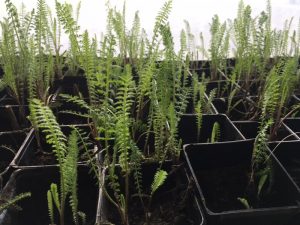
Photo: Allie Kuppenbender
WEDNESDAY
Wednesday, we finished up mulching the peony paths (Doug got more wood chips from the free place on Delphi on Tuesday). I learned some new things about peonies and tips/tricks on dividing the crowns. Depending upon variety, peonies can be divided every 3-5 years, but at the very least every 10 years if you want them to be productive (they can live up to 100 years without ever being divided, but the center on the crown will die over time as the eyes spread outward). Peonies don’t really like being lifted, though, and will take 1-2 years before you can start harvesting from them again.
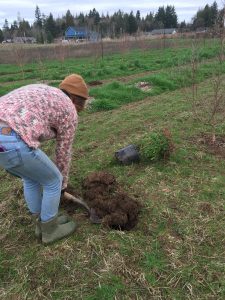
After the peonies, we finally planted the Pieris japonica in the west pasture! Pieirs japonica (Japanese Andromeda) is in the Ericaceae or heather family (so are blueberries) and many of these species like acidic soils, which was perfect because that pasture is slightly acidic–no need to add any lime. We planted 10 Dorothy variety in 1 gallon pots and 9 Snow Drop variety also in 1 gallon pots. There were also 1 of each variety, each in a 5 gallon pot. These pots came with slow-release fertilizer so the holes we dug didn’t need as much amendments as the cornus we planted week 1. Again, we dug holes two times as wide and as deep as the pot we were planting. In the hole, we added 1 cup bonemeal, 1/4 cup azomite, 1/4 cup sulfur, and a pinch of borax.
We also continued with the yarrow planting. Only the yarrow potted up in the greenhouse remains to be transplanted into the field; everything else we got in on Wednesday.
Upcoming excitement: This Sunday (February 11th), Anika and I will be going with Doug to the Seattle Wholesale GrowersMarket Cooperative! As Valentine’s Day (the single most economically profitable day for flowers in the US) is next Wednesday, they are having a special market event for the florists to get their flowers so they can make their Valentine’s Day arrangements. It will be really cool to see the market in action and get a chance to talk to the employees of the market and the florists that frequent the market.
